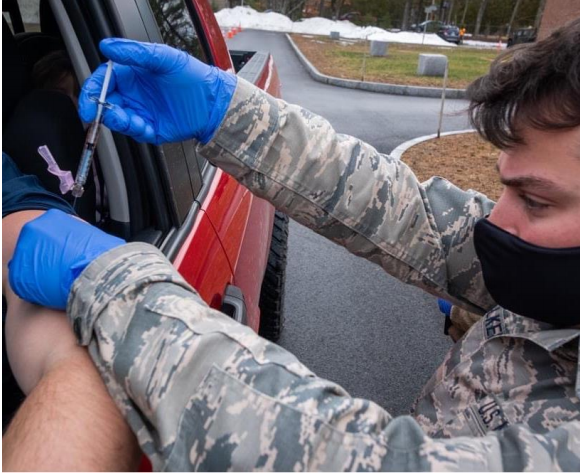By PAULA TRACY, InDepthNH.org
CONCORD – The state has identified 52 vaccine breakthrough cases with additional suspected cases under investigation, said Jake Leon, spokesman for the Department of Health and Human Services.
Of those 52 cases, two people have died, Leon said.
“While the vaccines are very safe and effective, breakthrough cases are to be expected, as no vaccine is 100% effective at preventing illness,” Leon said Monday, adding that number is expected to increase.
The definition of a vaccine breakthrough case is when it is verified that the patient tested positive for COVID-19 more than 14 days after completing a vaccine series.
Evidence shows that vaccination may make illness less severe in people who have been vaccinated but still get sick. The vaccines help protect people from getting COVID-19 and getting severely ill from COVID-19, and reduce the risk of hospitalization and death, he said.
New Hampshire health officials are closely monitoring anyone in the state who was fully vaccinated but still got infected with the virus.
J&J Vaccine
New Hampshire is going to resume vaccinating with J & J vaccine this week, Leon said.
Leon said as announced by NH DHHS on Friday, clinicians can resume use of the J&J Janssen vaccine after informing vaccine recipients about the potential, but very low risk, of rare blood clots.
The state-run vaccination sites and Regional Public Health Network partners will also resume use of the J&J Janssen vaccine this week for any person 18 years of age or older, in accordance with the FDA Emergency Use Authorization, Leon said.
The state is working to ensure its mass-vaccination and targeted vaccination clinics are able to do so with the necessary information and guidance in place to ensure that anybody receiving the J&J Janssen vaccine is appropriately informed of the very low risks for serious adverse events, including the new Thrombosis and Thrombocytopenia Syndrome (TTS) that has been identified in only a handful of people nation-wide, Leon said.
Dr. Beth Daly, chief of the Bureau of Infectious Disease Control at the Department of Health and Human Services, said last Thursday that there were then at least 24 people in the state who had been fully vaccinated and still became ill with COVID-19.
Daly said on Thursday that 56 percent of all eligible New Hampshire residents have signed up to receive one of the vaccines and that 984,000 have had at least one shot.
The state has among the nation’s highest percentage of fully vaccinated elderly and staff at long-term care facilities, 85 percent or more, and among the nation’s highest overall vaccination rates, Daly said.
Daly said: “We are monitoring the vaccine status of the cases that have been reported to us,” mostly through reports from New Hampshire health care providers. “We also do an investigation.”
“So we are tracking that information,” Daly said. “These are not unexpected,” unfortunately, she said, but noted that vaccinations have likely prevented many, many deaths and more serious illness.
Nationally over 7,157 of the 87 million people vaccinated had a breakthrough illness as of April 20 and one percent of that group had died, according to the Centers for Disease Control.
The CDC says women make up 64 percent of the breakthrough cases; above age 60 it was 46 percent of the cases, and having an asymptomatic infection was found in 31 percent of the cases.
The two vaccines approved by the FDA and the single-dose reapproved for emergency use authorization are highly effective and at 94 percent or more, in reducing death and hospitalizations, according to Gov. Chris Sununu. At his recent news conference Thursday, Sununu encouraged all people to get the vaccine to reduce the threat of serious illness.
In New Hampshire, breakthrough cases are being analyzed through contact tracing and Daly said the first thing the state verifies is the immunization information.
The CDC is carrying out “Phase 3” studies to figure out if there are trends, why this is happening and to whom.
The CDC is focusing on people who were in the trials, who were the first to get the vaccines months before everyone else, including about 40,000 people.
The CDC is looking at variants, demographics, and all sorts of data to try to figure out what happened. The CDC is examining trends such as whether the temperature of the vaccine was what was required by the manufacturer, for example.
“We are learning as we collect this data,” and far more data is coming in with every new shot given, Daly said.





